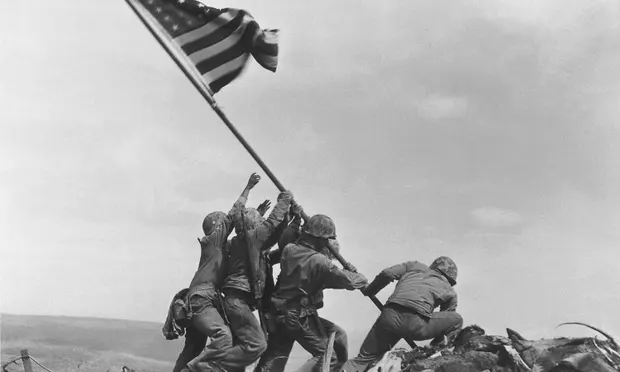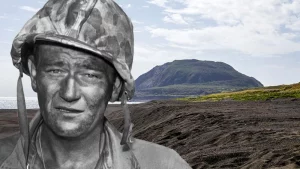If we live now in a post-truth world, is it something new and does it matter? Truth has always been a slippery fish to catch and hold.
Kellyanne Conway worked in Trumpworld, where ‘alternative facts’ (lies in old-speak) were part of the fabric, the warp and weft, of working life. But she was hardly ahead of her time.
When the first photographs were seen it must have seemed extraordinary, a miracle for those modern times.

A real moment in time captured and frozen for all to see. Portrait painters must have been less than enraptured – cutting edge technology with the power to put them out of business and no extra charge for two arms!
It didn’t take too long though for people to learn to pose for the camera, inventing for posterity domestic scenes of bliss and contentment.
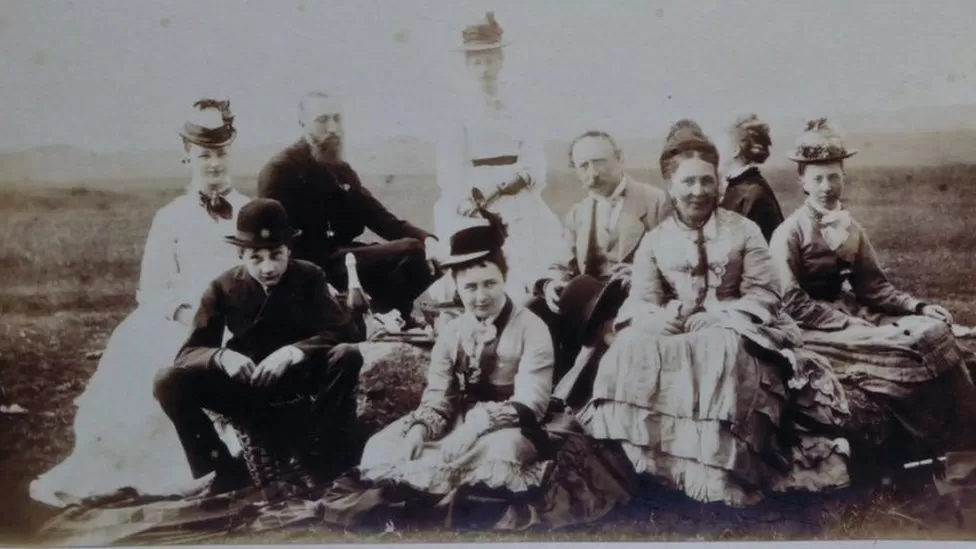

And of course it didn’t take long for people to realise photographs could be faked.
This came a while after the written word had been used, not to record but to embroider and even invent things that hadn’t happened. Fiction – written lies – were the first illusion to ripple the still waters of accepted truth (at least if we exclude politicians and con artists – always with us). Where we had had the comfort of reading or seeing performed versions of true(ish) history, bible narratives or equally credible myths of antiquity, suddenly these reliable journeys into our shared past were joined by a made-up world where anything could happen and outcomes were uncertain; it was hard to know what was true and what wasn’t. Surely ‘The Life and Surprising Adventures of Robinson Crusoe’ (1831) must be true – after all there were actual measurements and they couldn’t be made up could they? Except they were. https://victorianweb.org/art/illustration/cruikshank/crusoe/11.html
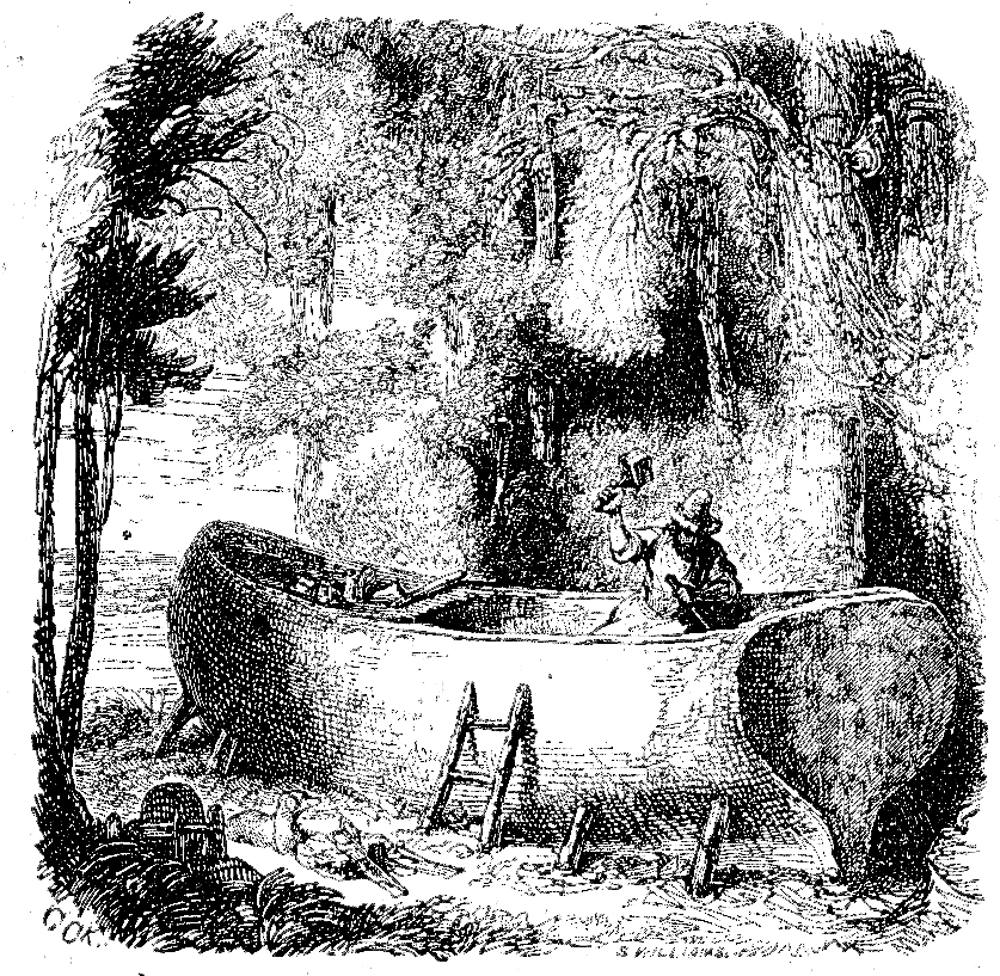
Crusoe builds a large dugout canoe by George Cruikshank The half-page vignette enforces the reader’s belief through such specific details as the dense jungle, the home-made ladder, and the props for the hull.
The birth of the novel was both fascinating and disturbing for early readers – church leaders were particularly incensed at losing their monopoly on true lies.The novel brought the end of certainty about written truth. Bodice rippers, where libertines seduced and ravished innocent young women, gripped readers of all classes, scandalised the clergy and encouraged vicarious living. ‘Clarissa, ‘The History of a Young Lady: Comprehending the Most Important Concerns of Private Life. And Particularly Shewing, the Distresses that May Attend the Misconduct Both of Parents and Children, In Relation to Marriage’, by Samuel Richardson, scandalised and titillated in equal measure.
Before all this, truth was either what the bible said, the vicar’s spin on it or the evidence of our own eyes. Fiction gave us ‘alternative truths’ and, ironically, the camera brought the promise of capturing the ‘evidence of our own eyes’. War correspondents could offer a pictorial record to support their words and expose something of the reality of war – seeing really was believing, though the person behind the lens could be a tad selective, either for reasons of good taste or something less commendable.
The first photographs of war were made in 1847, when an unknown American photographer produced a series of fifty daguerreotypes depicting scenes from the Mexican-American war in Saltillo, Mexico. These images covered a range of subjects, from portraits of generals and infantrymen to landscapes, street scenes, and post-battle burial grounds. While the images provide insight into daily life on the periphery of the war, they are especially notable for what they do not depict: in them, we see neither active battles or wounded and dead bodies, nor the idealization and glory sometimes associated with war.
Seeing is believing: early war photography Artstor
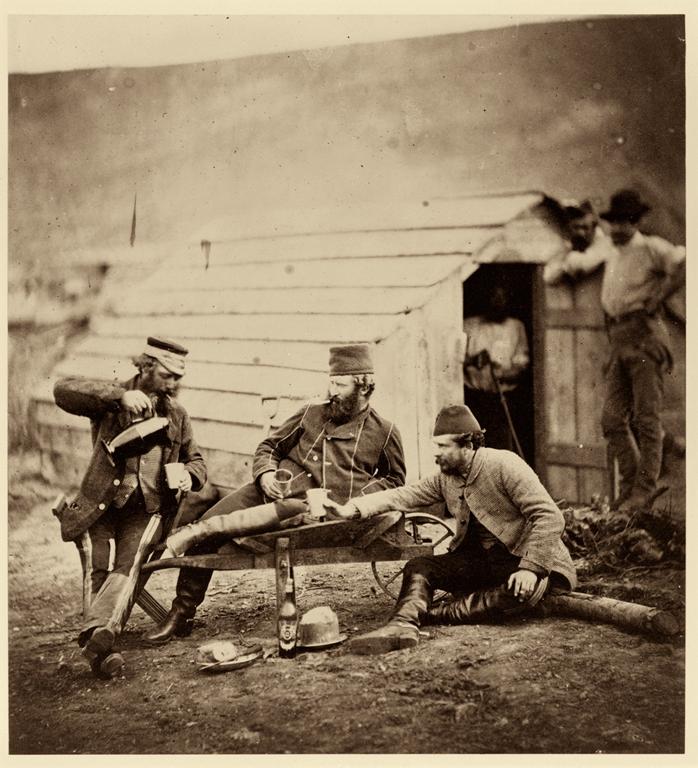
So, while the camera never lied, photographers did:
The Valley of the Shadow of Death, one of Fenton’s best-known images from the conflict, indirectly portrays the horrors experienced by troops undergoing heavy fire via a road covered heavily with cannonballs. Fenton almost certainly staged this photograph, moving additional cannonballs into the road to emphasize the horrific bombardment experienced by troops marching on the road days earlier, rather than documenting casualties of the attack.
Ibid
Then came movies, films of things that happened or might have happened or were just plain made up for entertainment! Imagine the delight and shock of watching real people moving and (eventually) talking, who were not really there; moments from the past captured to be relived as if happening now, and viewed in the magic, shadowy cinema darkness. There had always been celebrities, though in the distant past most people knew of them but would never see them. Kings, queens and other nobs were distant objects in another universe for most of the human race, and most members of the human race were safer because of it. Who would have wanted to be Henry VIII’s mate? Not me guv! The camera and moving pics. changed all that with a vengeance. Not just one but loads and loads of stars were born – well, manufactured at any rate. And Hollywood and TV studios, with judicious help from the CIA purse when needed, conquered the world with movies like ‘Birth of a Nation’, films featuring plucky western pioneers fighting frightening and savage ‘hostiles’, or focussing on the danger of communist infiltration as McCarthyism took root in the paranoid lobe of US brains. The poster for one Red Menace film declared it
So shocking it was filmed behind locked studio doors
adding that
Using the guise of ‘Moral Values’, the Red Menace creeps like a cancer across the land, poisoning minds, corrupting our youth, threatening world peace, sowing hatred, intolerance, cultural division, greed, injustice, arrogance, and delusions of superiority, and cutting a wide swath of war, death, devastation, disease, and human misery abroad.
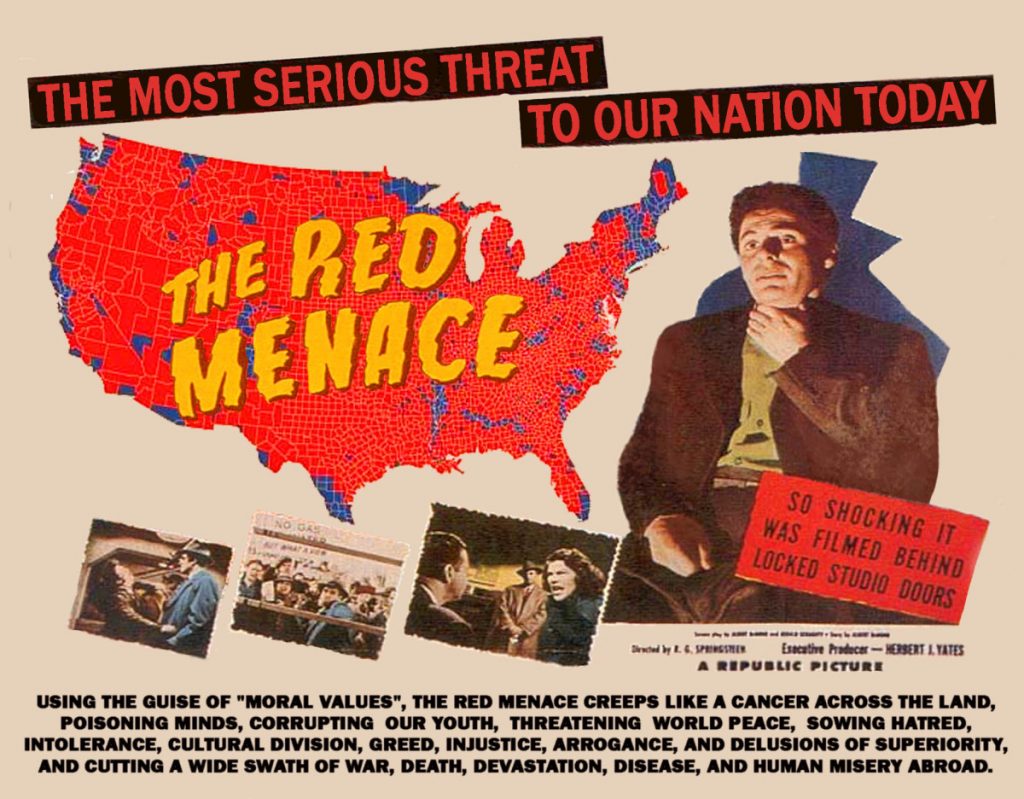
Misuse of the comma is the worst fault here but it is worth remembering that there’s a bit of pot and kettle about the CIA and white corporate America complaining about ‘cultural division, greed, injustice, arrogance, and delusions of superiority’.
Hollywood entertainment was the most effective soft-power ever, showing the world the American way of life, freedom, heroism, opportunity and unimaginable prosperity. A polarised cold-war world slugged it out in propaganda wars having learned from two world conflicts that controlling the narrative was almost as important as controlling the battlefield. Did the Germans actually bayonet babies when they invaded Belgium in WW1? The jury’s out. Was there an industrial scale attempt to exterminate Jews, Romanies, ‘mental defectives’ and communists in WW2? Most of the world would say Yes because there is compelling evidence that the Shoah, the killing of nearly six million Jews in Europe was not a nightmare but a terrible crime against humanity. But, here’s the thing, there are people who deny the Holocaust ever took place and claim it to be part of a plot by ‘international Jewry’ or some other invented organising group posing a threat to us all. Can evidence be made up? Can ‘truth’ be manufactured? Can any crazy thing be faked?
Of course it can. Most people know that the iconic raising of the Stars and Stripes at the battle for Iwo Jima (March 1945) actually did take place after terrible fighting during the war in the Pacific but was then restaged as a photo. opportunity for the ‘folks back home’ not to mention the generals – a ‘true lie’? And, of course, Hollywood made a film about it:

Then came Mark Zuckerberg and Facebook, now Meta, apparently a chance to be immersed in any kind of non-reality you like, Soma on an iPhone. Imagine actually designing a programme that would only connect you with people who believed the same things you did – a perfect recipe for delusional conspiracy theories. Try posting that Liz Truss is a Martian or Barak Obama isn’t American and you’ll soon have a following. Only a true anorak could think it was better to link together groups who agreed, whatever they believed, rather than binding humanity together across belief systems. Facebook’s revenue in 2020 was 85.96 billion USD, quite a powerful incentive to allow freedom of hatespeech on a platform. Meanwhile Twitter’s new owner has his own ideas about how to save humanity.
Just three days after Elon Musk bought Twitter, he posted a tweet promoting the baseless allegation that Paul Pelosi, the husband of the speaker of the House, who was assaulted on Friday at the couple’s home, had been drunk and in a fight with a male prostitute….. “There is a tiny possibility there might be more to this story than meets the eye” and (he) then shared a link to an article in a faux newspaper, the Santa Monica Observer…..that in 2016 claimed that (Hillary) Clinton had died and that a body double was sent to debate the Republican presidential nominee, Donald Trump.
Robert Reich, Guardian, Monday Oct. 30th 2022
So we now live in a world of manipulated images. Sometimes this is art for art’s sake and sometimes it’s to make money or to gain or keep power. We can buy a phone now which features a camera offering image manipulation on the go. Someone you don’t want in the pic?, easy just remove them to create your own reality. Something you don’t like about yourself or your life? Easy just embroider things on your Facebook pages. For many of us, the reality of our experience seems less important than other people’s perception of our lives. Social influencers don’t make money promoting reality. I don’t want to suggest that social media is always a malign addition to our tottering civilisation; it offers a platform with instant access to oppressed people and an organisational tool for protest. Information is the enemy of repression. Just ask Iranian women and men taking to the streets or Ukranians living in cellars in the middle of a war. Like a loaded gun, the harm or benefit brought by social media depends on who’s controlling it and why. It’s no surprise that oppressive regimes across the world work hard to control media and shut down what they can’t control.
Some politicians have always lied of course but it took Trump and Kellyanne, not to mention our own diminutive mini-Trump, Alexander Boris de Pfeffel Johnson, to really appreciate that we live in a post-truth universe. We don’t need evidence any more. A genuine or faked photo, email or video is now redundant. We don’t any longer need to manipulate records to prove our dubious assertions, that’s simply unnecessary; all we need is “alternative facts” – much more powerful than truth. The likes of dodger Johnson was entranced that what had been ascribed to his appalling narcissism could win an election and a referendum. In the UK the single most destructive economic decision in our history was taken on the back of blatant lies and, while there was some blowback, characterised as ‘remoaners’ being bad losers, nothing happened….unless you count the trashing of the UK economy.
In the US as in the UK an incredible number of people believe total bollocks because it fits their world view. Anything can be true, from paedophile rings in pizza bar basements to ‘stolen’ elections or ‘trickle down economics’.
Here are a few examples of what Marjorie Taylor Greene claims to believe: the 9/11 attacks were an inside job, mass shootings are staged by gun control proponents, “beams of blue light” from space-based “solar generators” started forest fires in California and a “global cabal of Satan-worshipping paedophiles” runs America. And here by contrast is what one ancient Roman believed:
If someone can prove me wrong and show me my mistake in any thought or action, I shall gladly change. I seek the truth, which never harmed anyone: the harm is to persist in one’s own self-deception and ignorance.”
Simple Meditations from Marcus Aurelius
For a well-researched piece on US conspiracy theories have a look at: So When, Exactly, Did Conspiracy Culture Stop Being Fun?, Rani Baker, Medium, Oct 20
There’s no moral to this post but I can’t help thinking we live now in a world where truth has no longer to be a significant component of our discourse and holding on to what we think is true is harder than it ever has been. The choice seems to be between devoting time and energy into sifting probable truth from the mass of static and manipulation or just believing whatever chimes with our world view….. and our world view depends on how we are able to access information about the world we live in – the perspectives of many a North Korean, middle-aged Russian, Canadian, west-coast American, mid-west American, Chinese citizen etc. will almost certainly not align because of the ‘education’ they have experienced and the bias always present in the media worlds they separately inhabit. Most of humanity just doesn’t have time to do more than work too hard to make ends meet and take what pleasure they can in increasingly difficult economic and social environments; sifting truth from true lies from lies is so much harder than just affiliating with a belief system and world view we can live with and, all too often, kill or die to defend. Today we seem to have exchanged harmless illusion for harmful delusion and, as my mother used to say, “No good will come of it.”
Oh yes….and then came AI great at diagnosing disease but very, very frightening when it generates all the alternative truths you could imaging, a selection box of world views and conspiracy theories.

